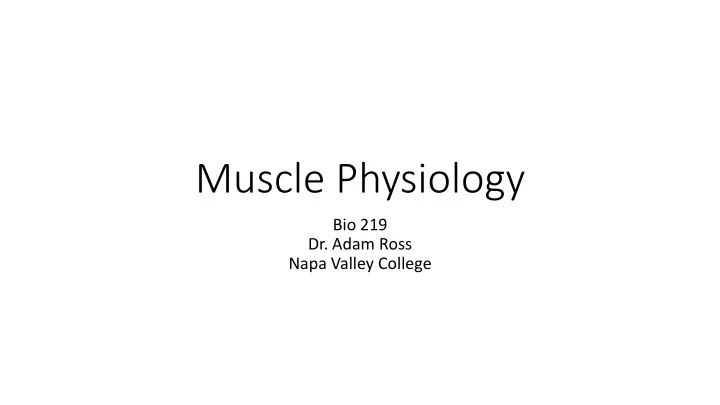

Muscle Physiology Bio 219 Dr. Adam Ross Napa Valley College
Muscle tissue • Muscle is an excitable tissue capable of force production • Three types • Skeletal- striated, voluntary • Cardiac- non-striated, involuntary • Smooth- striated, involuntary
Structure of Skeletal Muscle
Neuromuscular Junction
NMJ- Micrograph
Nicotinic Acetylcholine Receptor
nAChR
Events at NMJ • Action potential causes Ach release • Ach binds to nAChR • Allows Na+ to enter muscle cell (EPSP) • Depolarization from Na+ causes opening of voltage-gated Na+ channels • Leads to AP in muscle which spreads via T-Tubules* • *(will come back to this shortly) • ACh is brokendown by acetylcholinesterase (AChE) • Also pumped back into presynaptic neuron
Structure of Skeletal Muscle • Epimysium surrounds entire muscle • Fascia surrounds individual fascicles • Fasicle is made up of individual muscle fibers
Structure of skeletal muscle fiber
The Sarcomere • Functional unit of skeletal muscle • Smallest unit that retains all the functional properties • Easy way to understand what the whole muscle is doing is to focus on one sarcomere • In most cases (all in this class) all sarcomeres are doing the same thing within a single muscle
The sarcomere
The Sarcomere • Major Functional Proteins: • Actin: Thin filament • Myosin: Thick filament • Troponin + Tropomyosin : Block Actin from interacting with Myosin • Other important structures: • Sarcoplasmic reticulum • Contains calcium • T-Tubule • Carries depolarization (from motor neuron) across entire muscle fiber
Skeletal Muscle Fiber
T-Tubule/ Sarcoplasmic Reticulum
T-Tubule/ Sarcoplasmic Reticulum • * T-Tubule is depolarized by AP from NMJ (from earlier) • That depolarization spreads across the muscle fiber and depolarizes the S.R. • Causes calcium efflux from S.R. into the sarcoplasm • Conformational change of troponin/tropomyosin complex caused by Ca 2+ binding to Troponin • Opens the myosin binding site on actin *(more on this soon)
Molecular Basis for Contraction
Sliding Filament Theory
Sarcomere micrograph
Basic Events of Muscle Contraction • Depolarization spreads across T-Tubules • Causes calcium release from S.R. • Calcium binds to troponin • Causes conformational change in troponin-tropomyosin complex • Myosin binds to actin • ATP is used • Myosin head pulls Z-lines closer together
Actin and Myosin (Thin and Thick Filaments)
Skeletal Muscle Contraction
Length-Tension Relationship (Sarcomere)
Muscle-Bone-Tendon Systems • Muscle is attached to bone by tendons. • Force produced by muscle pulls on tendon, which pulls on bone • Creates movement around a fixed point (joint) • Muscles can only pull (not push) • Muscles are in antagonistic pairs • Ie biceps and triceps OR Quadriceps and hamstring
Types of Contraction • Isometric • No change in length of muscle • Eccentric • Muscle is lengthening • Concentric • Muscle is shortening
Muscle Twitch • Smallest single contraction possible from a single motor unit • If muscle is not allowed enough time to relax, twitches can summate
Motor Units • Single motor neuron and all fibers it innervates • All fibers activated at same time • Different size motor units: • Small: precise, delicate movement- fingertips • Large: less delicate, for posture, movement- muscles in trunk, lower back • Motor units are recruited by size: • Smallest to largest • Picking up keys vs. picking up 50lb bag of groceries • Idea is to use as little energy as possible • Recruitment results in additional force production (more fibers to contract)
Motor Unit
Summation in Skeletal Muscle • Spatial • Recruitment of motor units • Temporal • APs fire at faster rate • Tetanic contraction • Results from summation of a single fiber/ motor unit
Muscle Fiber Types • Glycolytic • Rely on glycolysis for energy (Glycolysis) • Oxidative • Rely on aerobic metabolism and need oxygen • Twitch • Fast • Slow • Tonic
Human Twitch Muscle Fiber Types
Regulation of Muscle Size • Balance of hypertrophy and atrophy • Gene expression plays a large role • Steroids cross membrane and bind to receptors to alter gene expression • Presence or absence of protein in diet can affect muscle growth • Aging causes muscle loss • Sarcopenia- 0.5%-1% loss per year after age 50 • Muscles that are used grow • Increase fiber size, not number of fibers • Muscles that are not used will atrophy • Muscle atrophy can exacerbate symptoms in elderly bed ridden patients
Disorders of Skeletal Muscle • Amyotrophic Lateral Sclerosis (ALS or Lou Gehrig’s Disease) • Lack of muscle growth due to removal of myelin on motor neurons • Myasthenia Gravis • “Grave muscle weakness” • Caused by overactive acetylcholine esterase
Recommend
More recommend